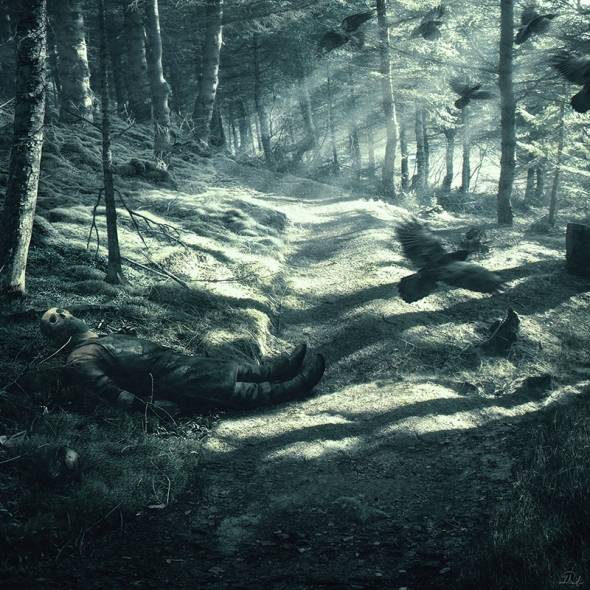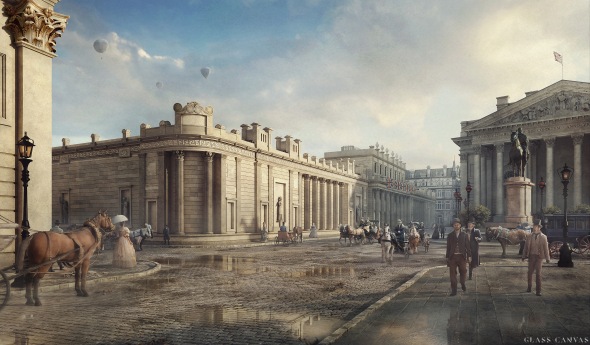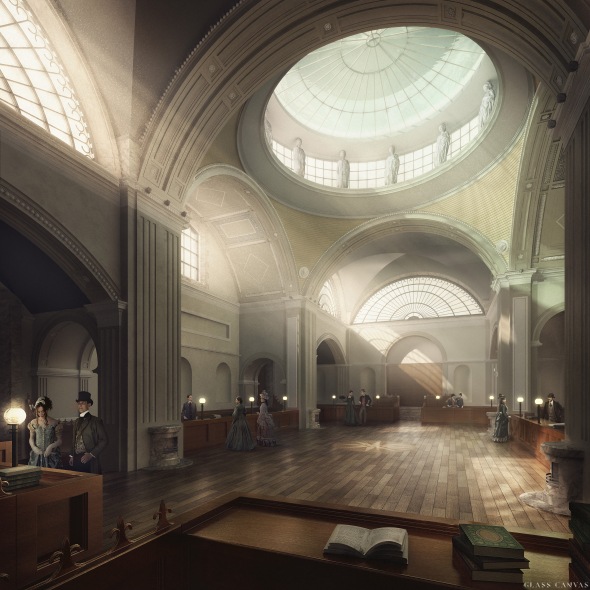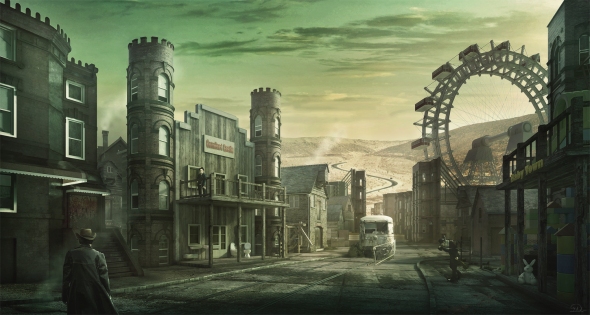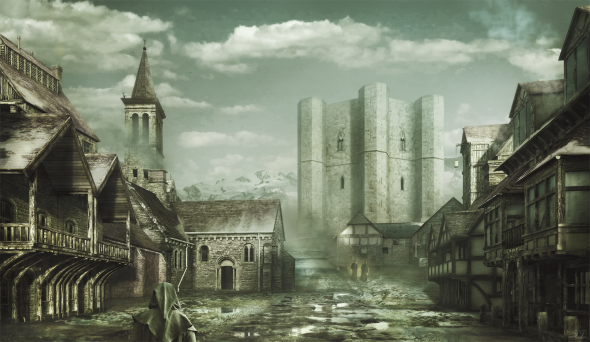
Concept art inspired by Umberto Eco’s description and drawing of the mysterious abbey from his novel. The aedificium is visible in the distance.
Most 3D buildings were downloaded from DarkAnvil.
Latest
The Name of the Rose – Illustration
Tribute to ‘Todbringer’, Ellende Album Cover
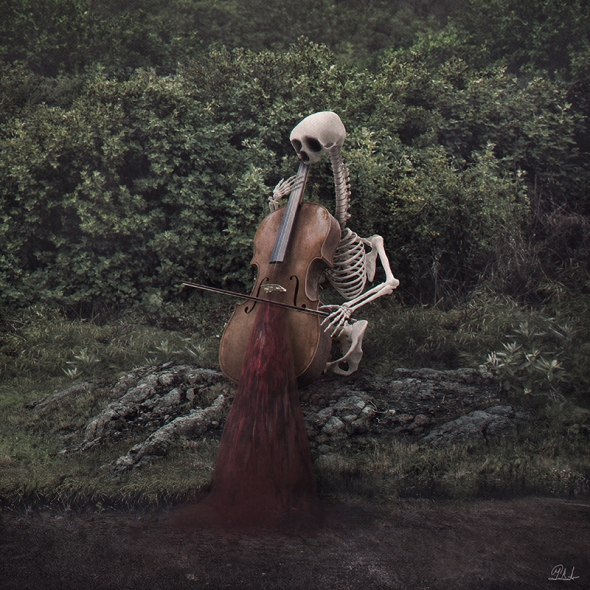
Full size: 3500×3500 px. Mixed technique – 3D render + matte painting.
There’s an interesting story behind this painting. I’ve been subscribed to a YouTube channel called ‘Atmospheric Black Metal’ for a while when this album, ‘Todbringer’ by Ellende came out.
I remember listening to it and admiring the artwork, then totally forgot about it for more than a year until one day I accidentally saw a flash of the cover somewhere on the internet. I could not remember its name nor the name of the artist so I went back to the YouTube channel and browsed through the huge collection of albums until I finally found it.
The original image was painted by Lukas, the talented musician himself.
Sublime Experience – Skyrim
“Skyrim” (video game) seems to be the perfect case study that illustrates the ways in which designers of virtual worlds create sublime aesthetic effects. As shown in the previous article, the aim of ‘alternate history’ designers is to create an environment characterized by otherness, evoking a different space-time. The chosen mythical world is the western Middle Ages, as described in Germanic legends such as “Beowulf”, “Volsunga Saga” and the “Poetic Edda”, filtered through J.R.R. Tolkien’s writings. If the legends and sagas already projected their mythical approach on history, Tolkien went to a totally new level when he invented an entirely fictional Universe, ‘the Middle Earth legendarium’.
“Bethesda Game Studio” continued Tolkien’s approach through further mixing his ‘legendarium’ with ancient legends. In the end, they came up with an entirely new world – the continent Tamriel, located on planet Nirn. All the history of Tamriel was recorded in a vast archive – ‘the Lore’, which constituted the basis of all video games in the ‘Elder Scrolls’ series, including ‘Skyrim’.
1. Natural Sublime. While playing ‘Skyrim’, the first way of experiencing the sublime is related to the breathtaking natural landscapes, drawing inspiration from Scandinavian and Siberian landscapes, which presented the necessary degree of otherness. You are removed from your familiar space-time and become immersed in a picturesque natural world with huge mountains, cascades, valleys and caves. Areas of tundra alternate with cold regions covered in snow, icebergs and glaciers; the relief map is designed to keep the player in a continuous state of awe through various scenographic effects such as magnitude, ascending/descending views, panoramas, picturesque, immediate contrast between different effects. The sublime varies from ‘the splendid’ to the ‘terrifying’, in Kant’s terms, or from the weakest feeling of sublime (‘light reflected off stones’) to weaker feeling of sublime (dark and deserted Northern landscapes with icebergs and glaciers, forgotten glacial caves) in Schopenhauer’s terms.
2. Historical Sublime. The dwellings scattered across the landscape instill other types of ‘sublime’ through various effects. In terms of scenography, the villages and citadels feature the same effects used for the natural landscapes – magnitude (Solitude), picturesque (Windhelm), contrast (Markarth), ascending or descending views. In terms of ‘historical sublime’, the dwellings appear as deja vu images from medieval cities. Their architecture and urban composition evoke viking or saxon cities with Romanic or Gothic cathedrals and monasteries, picturesque fortified castles and dense houses, scattered inside the citadels, giving a sense of organic development and historical depth. Everything, from the interior of inns to temples and palaces, is consistent with the evoked time period.
a. Mythical Sublime. The designers also added a mythical ‘Celtic/Germanic’ layer, in order to enhance the ‘otherness’ of the virtual world: the people of Tamriel worshiped pagan deities, “the 9 divines”, who often mingled in humans’ affairs. The races of the continent’s inhabitants also reflect this legendary Universe: humans, elves, orcs, dwarves etc. Legendary themes such as ‘killing the beast’, ‘the world eater’, ‘the trickster deity’, ‘the quest for the holy artefact’, ‘the land of the dead ancestors’ are integrated in the game’s stories. The mythic layer is also emphasized through Stonehenge-like ancient altars, burial grounds and ruined cities scattered throughout the landscape, whose purpose was long forgotten. Tolkien’s influence and its visual materialization through the ‘Lord of the Rings’ series has become a tradition in itself, carefully integrated by Skyrim’s concept artist, Adam Adamowicz. Thus, the city of Whiterun in Skyrim evokes Edoras in LotR; Markarth evokes Minas Tirith, the underground burial tombs evoke the depths of Moria and the Paths of the Dead; the elvish, dwemer and orc armors are obviously borrowed from the LotR trilogy etc.
b. Steampunk, Gothic, Lovecraft. The historical sublime is also present through the integration of ‘alternate worlds’ in the world of Tamriel. The long extinct dwarves (‘dwemer’) were an ancient, technologically advanced civilisation that built complex underground cities and galleries. They used mainly steam-powered machinery, built defensive mechanisms and dragged natural light through pipes deep into their underground cities. Here Adam Adamowicz was clearly inspired by Steampunk art (the 1900’s steam technology reimagined); however, in order to give it an ancient mythic flavour, he mixed it with Mayan architecture and decorations – the cities of the dwarves are carved in stone, probably evoking the ancient city of Petra as well. The complexity of these ruins, along with their magnific scale, age and mystery (no one knew the reason of the dwarves’ disappearance, their ruins were still full of their artefacts, dangerous traps and automatons) evokes a complex feeling of historical sublime.
The Gothic subculture is also introduced in the world of Tamriel through the ‘Dawnguard’ campaign; there are vampires in Skyrim, living in dark palaces, feeding on human cattle. Finally, H. P. Lovecraft’s world is introduced in the game through the ‘Dragonborn’ campaign as the separate realm of ‘Apocrypha’, in which mortals might gain access through reading ‘Black Books’ of hidden knowledge. All these mixed virtual realms accentuate the feeling of ‘otherness’, complexity beyond comprehension and grandeur.
3. Music. Skyrim’s soundtrack was composed by Jeremy Soule, an eclectic new age musician with clear historical influences such as pre-classical (Bach) and Romantic music (Grieg, Wagner). His music enhances the different types of ‘sublime’ experiences:
-natural sublime (splendid sublime: The Jerall Mountains, Kyne’s Peace, Distant Horizons, terrifying sublime: Aurora, The Gathering Storm, Frostfall, Tundra),
-historical/mythical sublime (From Past to Present, Solitude, The Streets of Whiterun, The City Gates, Far Horizons, Ancient Stones, Wind Guide You, Journey’s End).
The soundtracks become associated with the various types of landscapes and experiences in the game, contributing to the overall effect.
After experiencing the virtual realm of Tamriel, ‘Skyrim’ remains recorded as a vivid memory, a journey into ‘othernes’. After a few years, you might even become nostalgic of that realm, as many players confess. Therefore, I believe the game is one of the best examples of ‘legendariums’ offering a vast array of complex feelings of sublime.
London Luton Airport – Visuals
As part of ‘Glass Canvas’ team I worked on a few images picturing Luton Airport’s redevelopment. The images were featured on several websites:
Glass Canvas, London Luton Airport, Business Quarter, Luton Today
Case Study – Sunshine (2007) – Fascinating vs. Terrifying Sublime
The movie ‘Sunshine’ illustrates the concept of ‘sublime‘ better than anything else I came across so far. It emphasises every aspect of it and in the end it presents two typical reactions humans have when confronted with greatness beyond comprehension. If you haven’t watched it, please be aware this article contains spoilers. Read the rest of this page »
The Aesthetic Category of ‘Sublime’
Since my approach on art is heavily influenced by the aesthetic category of ‘sublime’, I’m posting a short article that will hopefully help others to become familiarised with this
Since our approach on art is heavily influenced by the aesthetic category of sublime, it is worth posting a short article that will hopefully help others to become familiarised with this concept and expand their creativity.
Known since the 1st century AD, the term ‘sublime’ was rediscovered in the 16th century and became a familiar subject in British and German philosophy. It signifies an aesthetic emotion of awe when confronted with greatness beyond comprehension, and was first used to describe natural landscapes.
Edmund Burke’s essay ‘A Philosophical Enquiry into the Origin of Our Ideas of the Sublime and Beautiful’ (1757) was an essential contribution to the development of the notion. Burke understood sublime as a physiologically response to terrifying phenomena (Alison Smith, ‘The Sublime in Crisis – Landscape Painting after Turner’), calling it an instinct of self-preservation:
“Whatever is fitted in any sort to excite the idea of pain, and danger, that is to say, whatever is in any sort terrible, or is conversant about terrible objects, or operates in a manner analogous to terror, is a source of the sublime; that is, it is productive of the strongest emotion which the mind is capable of feeling … When danger or pain press too nearly, they are incapable of giving any delight, and are simply terrible; but at certain distances, and with certain modifications, they may be, and they are delightful, as we every day experience” – Burke, Idem.

‘The Wreck of a Transport Ship’ by William Turner
For Burke the triggers of the sublime were darkness, obscurity, privation or vastness – qualities he associated more with terror than elation (Smith, Idem).
He considered sublime and beauty to be mutually exclusive, despite the fact that both can produce pleasure:
“Beauty may be accentuated by light, but either intense light or darkness (the absence of light) is sublime to the degree that it can obliterate the sight of an object. The imagination is moved to awe and instilled with a degree of horror by what is “dark, uncertain, and confused.” Burke, Idem.
In continental philosophy, Immanuel Kant’s understanding of the sublime dominated. Although he was influenced by Burke, he regarded the concept less in empirical terms and more as a mental condition or an aesthetic experience that resulted from a strain in perceiving a boundless or infinite vista (Smith, Idem).
Categorisation
In Kant’s view, there are three kinds of sublime: the noble, the splendid and the terrifying (Wikipedia, Sublime philosophy). Schopenhauer went even further by dividing sublime in five categories based on intensity:
“Weakest Feeling of Sublime: Light reflected off stones. (Pleasure from beholding objects that pose no threat, yet themselves are devoid of life).
Weaker Feeling of Sublime – Endless desert with no movement. (Pleasure from seeing objects that could not sustain the life of the observer).
Sublime – Turbulent Nature. (Pleasure from perceiving objects that threaten to hurt or destroy observer).
Full Feeling of Sublime – Overpowering turbulent Nature. (Pleasure from beholding very violent, destructive objects).
Fullest Feeling of Sublime – Immensity of Universe’s extent or duration. (Pleasure from knowledge of observer’s nothingness and oneness with Nature)” – Arthur Schopenhauer, “The World as Will and Representation”, p39.

‘The Wave’ by Ivan Aivazovsky
Rudolf Otto popularised the term ‘numinous’, deriving from the Latin ‘numen’ which means ‘arousing spiritual or religious emotion; mysterious or awe-inspiring’ – Collins English Dictionary -7th ed. – 2005. The numinous, which roughly corresponds with the continental definition of the sublime, was further divided by Otto into two components: the splendid and the terrifying, or mysterum tremendum (causing you to tremble) and mysterum fascinans (exhibiting fascination) – Rudolf Otto, ‘Mysterium tremendum et fascinans’.
Many painters of the early Romantic movement tried to evoke the sublime quality of nature by focusing on its terrifying qualities. Towards the second half of the 19th century critics started to doubt that painting is an appropriate medium for evoking the turbulent nature of terrifying sublime. The art of the later half of the 19th century focused mainly on evoking clearly articulated forms of beautiful landscapes that were supposed to elicit disinterested rather than disturbed emotions in the viewer. The Burkean sublime continued to have an impact in poetry as well as in the field of popular culture, theatrical entertainment and illustration more than in the fine arts (Idem).
John Ruskin rejected the sublime as a discrete category, although he showed great interest in Burke’s ideas:
“Anything which elevates the mind is sublime, and elevation of mind is produced by the contemplation of greatness of any kind … Sublimity is, therefore, only another word for the effect of greatness upon the feelings – greatness, whether of matter, space, power, virtue, or beauty: and there is perhaps no desirable quality of a work of art, which, in its perfection, is not, in some way or degree, sublime” – Smith, Idem.
Technological Sublime
Over the course of the same century the term started to be used not only to describe nature, but also artificial structures and landscape. In Hegel’s view, the excessive detail in Chinese art or the overwhelming decorations in Islamic mosques should be considered sublime. “The disembodiment and formlesness of these art forms inspired the viewer with an overwhelming sense of awe” (Wiki, Idem). Walter Benjamin experienced feelings of sublime while contemplating historical cities (Christine Boyer, “The City of Collective Memory”), while others like Ruskin, Piranesi or Speer experienced the sublime when contemplating ancient ruins.
Historical Sublime
Although I haven’t specifically encountered the term ‘historical sublime’, it seems necessary as a discrete category to the extent that the complexity and richness of a perceived historical heritage and its relation to the passage of time can evoke emotions of fascination of terror. The nostalgia of a past era, the otherness’of its relics or the mere acknowledgement of their great age and the irreversibility of time might overwhelm the beholder and evoke his own insignificance. The relic’s scale might vary from an old deserted house to a cathedral or an entire historical city.

‘Klosterruine Eldena’ by Caspar David Friedrich
Technological Historical Sublime. Popular Culture
In Mario Costa’s view, in the 21st century the concept of ‘sublime’ has become linked to digital technologies and the new technological productions: “new media art, computer-based generative art, networking, telecommunication art” (Wiki, Idem). These might be seen, of course, as tools of progress, contributing to a glorious future or, on the contrary, as useful tools for investigating the past in creative ways and bringing it to life. You get a much stronger feeling of sublime when contemplating a digitally restored ancient environment than when seeing a relic in a museum.
Modern art, in its rejection of aesthetic categories, gave up on the pursuit of either beauty or the sublime and therefore became unintelligible and irrelevant to the interests of the masses. Although postmodernism embraced both nostalgia for past ages and the interest in pop culture, its ironic quotations and its irreverent deconstructive approach was still inaccessible to the public and regarded as an elitist snobbery.
Popular culture genres such as novels, cinematography and video games seemed much more interested in exploring historical sublime. The American dinosaur mania of the 20th century induced a fascination with prehistory which became tangible through films like ‘Jurassic Park’. Historical films or video games brought the past back to life in colours undreamed by the Romantics of past ages. While playing a game from the ‘Total War’ series one can literally feel the mix of fear and patriotism of the soldiers fighting off an invading horde. The more immersive the production, the fuller the sublime (on Schopenhauer’s scale).
In the context of new media, virtual simulation of the past transcended its mere imitation; it also created a new approach on history – ‘reflective nostalgia’ (Boym, Idem).

‘Total War Saga: Thrones of Britannia’ Screenshot. Source: PC Gamer
In this approach, the goal of the designer is not necessarily historical accuracy, but the production of an immersive world that would evoke a different ‘space-time’, a deja vu from history. The ‘alternate history’ approach produced genres such as Steampunk, Cyberpunk, Arcanepunk, Gothicpunk, Post-apocalyptic dystopia. Most of these genres deliberately mix the culture of a past age with the present culture; some speculate on futuristic developments of our world, some are based on ancient myths, while others imagine completely parallel worlds. The goal is to create an environment characterized by sublime and oherness – an alternative to the predictable world of the present. These environments are so vast and immersive, their architecture and characters are designed to such a degree of detail, that the beholder is confronted with greatness beyond comprehension. It feels like nothing they have ever seen. Vastness, complexity and lack of familiarity become the main ingredients in the products of historical sublime.
Strolling through Canary Wharf
Among the many places I like in London, Canary Wharf is one of the most distinctive. Walking through its deserted streets on early evenings is one of the weirdest experiences. Its vast glazed facades reflected in the canals, its eclectic postmodern offices, its low claustrophobic basement malls, frozen in the glossy architectural cliches of the 90s offer a sensation of otherness unlike any other place. Read the rest of this page »
Project Soane – Glass Canvas Entry – Honorable Mention
Project Soane organised a rendering competition whose purpose was the re-imagining of Sir John Soane’s Bank of England. Below are our studio’s entries on which I was assigned to work. I am pleased to have achieved an honorable mention for the view from Threadneedle Street (image below).
Clicking on any of the images above will redirect you to the voting section. The winners will be announced on July 15th; only five days left!
Ligotti’s ‘The Town Manager’ – Digital Art
Digital Art based on Thomas Ligotti’s story, ‘The Town Manager’. You can read it online here.
Step-by-step process:

